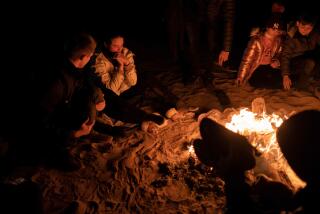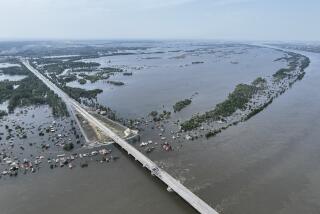Fatal Thaw of Russian Ice Fishing
- Share via
ST. PETERSBURG, Russia — Furry-hatted fishermen emerge like humpbacked trolls from stands of birch and pine at the shoreline. They carry stiff, square backpacks and strange, 5-foot-long corkscrews. They trudge out onto the ice, a white and gray expanse that glows faintly and stretches to the horizon.
For the most part, they walk alone and they walk for miles. They read the ice like oracles, seeking signs of life and tremblings of death.
Most come back alive. But every year dozens, perhaps hundreds, do not. And hundreds, sometimes thousands, find themselves adrift on thawing floes that shrink by the hour as they’re carried away.
“I once spent a night on a floe. Actually, two floes. It broke in half,” says a cranky fisherman in a black sheepskin hat who gives his name as Yevgeny Semyonovich. “Why do I risk it? Why not?”
Spring arrives in St. Petersburg with a lengthening of daylight, a quickening of wind and the sparkle of a humble little fish called koryushka.
The fish are just a few inches and a few ounces each. They smell like cucumber and taste vaguely of salmon. In English, they are known by a decidedly less melodic name: smelt.
Smelt may not be much to look at, but the annual migration stirs an instinct in fishermen as powerful and lethal as that which drives lemmings to the sea.
Indeed, ice fishing is ruled by a cruel paradox: The more dangerous the ice, the better the fishing. When the ice begins to melt, bubbles dissolve and release oxygen into the water, which stirs the fish, sluggish after a long winter in the cold. When the wind kicks up waves and cracks appear, the oxygen level climbs higher.
Why risk their lives for a satchel of smelt?
Semyonovich says he can’t feed his family on his pension alone. “I only caught two kilos [about 4 1/2 pounds] today,” he spits in contempt. “My wife will scold me when I get home.”
Boris Vilyo, a 64-year-old construction engineer with flyaway blond hair, says he likes the solitude, the fresh air and something useful to do on his day off. He says he once fell through the ice and spent three hours swimming and wading through slush before making it to shore. But year after year he returns.
“Of course, it’s scary sometimes,” he says, warming his hands in a homemade oilskin muff. “I don’t understand people who don’t pay attention to the dangers. But everyone understands danger in different ways, don’t they?”
And that may be the crux of the matter. As well as the fact that nowhere else on Earth are so many people--about 6 million--concentrated around so much ice.
The city of St. Petersburg straddles a bridge of land just 25 miles wide. To the west is the Gulf of Finland, a tongue of ocean that pushes past Estonia and Finland to lick the city’s shore. To the east is Europe’s biggest lake, Ladoga: about 130 miles long and an average of 50 miles wide, and home to four dozen species of fish. When winter arrives, a layer of ice creeps across both bodies of water.
The ice is seductive. Underfoot, it seems almost alive. It breathes, shifts, sings in the wind. It seems to have moods, changing from white to gray to black. The black ice is stronger but thinner, without bubbles. The white looks more solid but is often porous or slathered with icy slush, which Russians call “porridge.”
For the most part, the ice and the waters underneath bring life to this region, supporting shipping, fishing and tourism. When St. Petersburg, then known as Leningrad, was besieged for three years during World War II, the ice literally became a “road of life.” Trucks evaded the Nazi blockade by driving across Lake Ladoga, ferrying people out and food and ammunition in.
On this soft spring day, more than a mile out on the ice along the gulf’s northern coast near the village of Smylyachkovo, Vilyo seems to be having the best luck among a cluster of a dozen anglers. They have set their holes a wary distance apart--just close enough to spy on one another.
Vilyo stabs the point of his oversize corkscrew into the ice and turns the crank. The bit bites with a growling noise, which grows deeper as it burrows. He pulls it out with a rush of water and slush, leaving a dark hole about 5 inches across.
Koryushka rods are only about a foot long, with tiny red bobbers on the tips. They look fragile, like toys, but the fish tug gently. He sets his rods.
Vilyo travels by train and bus for three hours to get here, and he makes the trip at least twice a week. “What else am I going to do, sit at home?” He jumps up, pushes back a green knitted cap, and rapidly hauls in one of the lines hand-over-hand. On the end is a little silver fish. “What a cutie,” he says.
Nikolai Stepanov, a 33-year-old security guard, watches from his spot about 30 feet away and cracks a morbid joke: “The fish are biting in this spot for some reason. Somebody must have drowned.”
Signs of a Bad Day
Looking back, Maxim Balachevtsev realizes he ignored the omens.
First there was the vehicle that broke through the ice. It was midmorning on Sunday, Feb. 27, and he was driving onto Lake Ladoga with 10 friends in four cars. They were experienced fishermen. In fact, Balachevtsev, 27, is the editor of St. Petersburg’s Sport Fishing magazine.
They had driven about 1 1/2 miles out onto the ice when they saw the minivan sinking. They ran to the edge and a man struggled to the surface. As they hauled him out, he asked for his friend and Balachevtsev realized there had been another man in the van. The second man didn’t surface.
“He was the first victim of the day,” he says.
Balachevtsev and his friends were undeterred. They left the cars behind and continued more than an hour on foot. They reached the end of the older, whitish ice and walked onto the newer blackish ice. They stepped over a crack.
“Usually I don’t step over cracks like that, but because of the shock of the death, I guess I wasn’t paying enough attention,” Balachevtsev says.
The fishing, of course, was good. Balachevtsev caught more than 30 pounds of perch in less than two hours. And then he felt a new tug on his fishing line--not the jerk of a hungry fish, but the slow pull of quickening current.
The ice had broken free.
“You know right away when the ice starts to drift. We all jumped up and started shouting. Everyone started running.”
He didn’t know it yet, but the floe was huge: more than 10 square miles. There were more than a thousand people on it.
One was Nikolai Tropnikov, a 57-year-old short-story writer. He was walking toward a cluster of about 200 anglers, scouting for a new fishing spot, when “all of them jumped up simultaneously, like a flock of blackbirds.”
“I turned to face the wind and started running against it,” Tropnikov recalls. “The others ran the same way. I was sweating like a pig when I stopped in my tracks at the edge, paralyzed. There was a big stretch of black water, and it was widening rapidly.”
Often, when a floe breaks off, one corner clings to the rest of the ice, at least for a few minutes, and the quick-footed can get across before the floe heads for open water. But this time, the wind came up perpendicular to the shore and the break was clean.
Tropnikov watched a boy jump into the frigid water at the narrowest point, swimming about 80 feet to safety. A man followed but couldn’t make it. He drowned. Tropnikov learned later the man was the boy’s father.
Soon local residents began to arrive with small boats. Some of the drifting fishermen panicked. Balachevtsev watched as seven fishermen jumped into a vessel meant to hold four. The boat soon sank, and all eight men aboard drowned. Others stood on small floes and tried to paddle them like rafts to shore using their ice drills as oars. The wind pushed them back.
Some of the fishermen had mobile phones and alerted the rescue squad. The first helicopters began buzzing overhead in the early evening. Already that day, rescuers had plucked 30 people from the ice on the southern shore of the Gulf of Finland, and 17 more near the gulf island of Kronshtadt. It took them a while to reach Ladoga, and they managed to pick up only a few dozen people before night fell. The remaining fishermen--about 800 of them--prepared to spend the night on the ice.
They had to keep moving. The wind stayed strong, and the waves chewed at the floe. As it shrank, the fishermen retreated toward the center.
“We could hear the edge of the ice crunching and breaking behind us,” Tropnikov recalls. “We’d sit for half an hour and then walk for half an hour. At first, people carried their things with them, but we began to lose strength and started discarding stuff. I threw away my fish, then my drill. I tried not to think about anything, even about my wife or my children.”
By morning, the floe had shrunk to one-fifth its original size. While waiting for the helicopters, Balachevtsev squeezed in some more fishing.
“We had time to kill,” he says, only slightly sheepishly. “Why not?”
Four helicopters spent the better part of the day picking up the fishermen. By afternoon, the floe had broken into several pieces, some just a few yards across, and had drifted more than 10 miles out into the lake. As the choppers arrived, some fishermen were lying spread-eagled on partially submerged floes, stabbing penknives into the ice to keep from being blown off.
“When the helicopter came I was at the end of my reserves,” Tropnikov says. “I couldn’t feel the toes on my right foot. . . . I tried to climb aboard, but my strength failed me. I clung to the [rescue ladder’s] rungs lifelessly until one of the rescuers lifted me like a sack and threw me inside.”
Officially, 1,012 people were rescued and eight died--the men in the overloaded boat. But many people, including Balachevtsev, say dozens of deaths weren’t counted, including the man in the van, the drowned father and anglers who may have drifted off alone in the dark.
But both Balachevtsev and Tropnikov will fish again.
“When you have a car accident, you are in shock at first,” Tropnikov explains. “But then you get the car fixed and you get back behind the wheel, don’t you?”
“I don’t have a death wish,” Balachevtsev insists. “All I want to do is catch fish. I wish it was safer. Too bad it’s not.”
Busy Time for Rescue Workers
Alexander Shilin struggles into an orange dry suit. He is a trim man, 43, a veteran rock climber who is deputy chief rescuer for the St. Petersburg region. It’s a warm day in mid-April, and he’s having a busy weekend. “It’s a mess up there on the northern shore today,” he says.
It seems the ice off Smylyachkovo broke free late in the morning and dozens of fishermen are adrift. Boaters and a Hovercraft are picking up some. The chopper is heading out to look for stragglers.
“We have our own fishing season,” Shilin jokes. “It starts in November. What we catch are fishermen.”
St. Petersburg has just 45 professional rescue workers, employees of the national Emergencies Ministry, and they retrieve everything from cats in trees to fishermen on ice. Thanks to ice fishing, for most of March and April they barely get an hour off.
“Sure, sometimes I’d like to fine them, to punish them somehow,” Shilin says. “But when you pull them out of the water like drowned kittens, how can you get mad at them? They’re so grateful.”
The helicopter passes over the new edge of the ice, which breaks off just 200 yards from the beach. The day before it stretched for miles.
Shilin points to a scattering of small dark dots along the edge--fishermen who ventured out as far as they could go. “Look how many there are,” he says over the roar of the engine. “They look like little ants. You can even see their tracks.”
The tracks weave over what remains of the ice, ending abruptly at the edge. They seem like the trailings of ghosts, and maybe some of them are.
Officially, the Emergencies Ministry rescues anywhere from several hundred to several thousand fishermen a year. Private citizens who have sharp eyes and quick boats rescue at least that many.
But fishermen are a solitary breed. Emergencies officials say there is no way to tell how many may go off on their own, get in trouble and die without anyone knowing. “Are they crazy?” Shilin asks. “No, they’re Russian.”
Shilin has traveled to disaster sites around the world and has conferred with rescue workers from many countries. He’s convinced that Russians have a different sense of danger.
“In the West, you say that life is cheaper in Russia. Maybe that’s so. Maybe we don’t value even our own lives as much,” he says. “But any way you look at it, our understanding of risk is different. And it’s built into us. It’s part of us.”
His boss, Andrei Rubul, deputy director of the northwestern region for the Emergencies Ministry, notes that even though the Finnish capital, Helsinki, is also located on the Gulf of Finland, it has no comparable problem with floating fishermen.
“A Russian knows that he shouldn’t do this and he goes out on the ice all the same,” Rubul says. “A Finn knows he shouldn’t do something and he doesn’t. He stays home.”
After passing over open water, the helicopter finds the new floe. It takes half an hour to fly the length of it and circle back. The only signs of fishermen are their holes in the ice.
When Shilin returns to headquarters, another crisis is brewing. Two fishermen have been spotted 300 yards off Kronshtadt. Night is falling, the wind is strong, and they seem to be having trouble getting back to shore.
He’s reluctant to send a crew. “Of course we’ll go,” Shilin tells his boss after conferring by phone. “But you understand how big a risk it is.”
The team he sends has been out all day on Lake Ladoga, where they’ve already hauled in four wayward anglers. Wearily, they load a boat and outboard motor onto a truck and drive into the darkness.
Vadim Nenonen, 32, is the captain. He and two teammates, looking like cosmonauts in bulky hypothermia suits, haul the boat out onto the ice. Their headlamps contract to pinpoints, then disappear in the darkness. The bitter wind freezes all conversation among police and residents on shore.
The rescuers search for three hours before the headlamps bob slowly back. The ice has turned to porridge, Nenonen says.
“That’s it for them,” he says. “No one can survive out there that long.” He calls off the search.
Does he resent having to risk his life for foolhardy fishermen?
“Fishermen are all crazy, of course. It’s probably some kind of psychosis,” he says. Then he grins mischievously. “But I guess I have it too. I don’t mind a little fishing myself now and then.”
His attitude is common in these parts--half exasperation, half amusement. But if there’s one person in St. Petersburg who can no longer shrug off the phenomenon, it’s Anna Artamonova.
Artamonova’s 45-year-old husband, Valery, was one of the men Nenonen was searching for on the dark ice off Kronshtadt. His body turned up the next day. He died of hypothermia around dawn.
“He was like any other fisherman in Russia--he always thought that if something bad was going to happen, it was going to happen to someone else,” Artamonova says. “How desperate or reckless does a person have to be to risk his life for half a dozen fish no bigger than your palm?”
*
Sergei L. Loiko and Alexei V. Kuznetsov of The Times’ Moscow Bureau contributed to this report.
More to Read
Sign up for Essential California
The most important California stories and recommendations in your inbox every morning.
You may occasionally receive promotional content from the Los Angeles Times.










